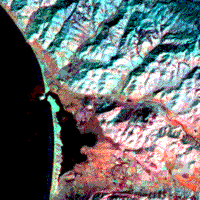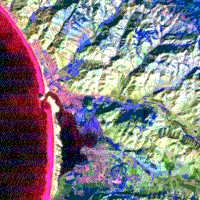

Reluctantly, we take leave of this attractive composite to examine several others made by using bands 5, 6, and 7 in some combinations. The first casts 5 as blue, 6 as red, and 7 as green.
 |
|
This combines the thermal band, sensitive to emitted radiation, (with its lower resolution 120 m. pixels) with two infrared bands, 5 and 7 (with their 30 m. pixels). In this color composite generated with IDRISI, the thermal band image (check TM 6 again) dominates. In the IDRISI mapping, reds and blues greatly outweigh any greens contributed by light tones in band 7. The reds represent the warmer surfaces, and the blues the cooler surfaces, as recorded in band 6. Note that the blues extend over a broader fraction of the hill slopes than we might expect from the shadow effects seen in other bands. In other words, the bulk of the back slope areas receiving less direct sunlight return less thermal radiation. However, some areas of blue that lie on the sunlit fore slopes are covered by the uplands vegetation at g and the grasslands at v, which offset the direct heating effect through cooling by evapotranspiration. Other areas supporting vegetation (as at y), and also along streams have dark red tones, not because they are hotter but because their tonal expressions in 5 and 7 are darker (almost no blue or green inputs).
Both urban communities show several shades of red, with the street patterns showing through because of their sharper definition in bands 5 and 7. This is, in part, due to the "urban island" thermal effect, which is the tendency of populated areas to be warmer because of heat-absorbing materials (darker streets, tar-covered roofs, etc.), reduced surface areas with vegetation, and heat emitted from furnaces, air-conditioners, and other human activities. Fully perceptible is the thermal plume emanating from the power plant (t), but the ocean sediments introduce no noticeable effect.
Some areas we see as green in the composite include the beach bar and several of the extraction pits (u). These surfaces reflect highly in most bands, hence, their light tones in bands 5 and 7 combine the blues and greens assigned to these bands whereas their darkness in band 6 (reflective materials are cooler) leaves red out.
Let's now experiment briefly with combining one of the reflective longer-wave IR bands (7, assigned to green) with the vegetation band, TM 4 (blue), and the ocean water/sediment band, TM 1 (expressed in red), as produced by the IDRISI Composite function. Remember it converts three 8-bit bands into a single 8-bit image that mimics the results of using the three bands to make a true 24-bit color image. The result is a colorful rendition that, in some respects, shows certain features best.
 |
|
Again, blues and reds are the prevailing colors, whereas greens are subordinate. The blues correlate closely with vegetation, which stands out in sharp contrast to most areas that either lack this cover or now support dormant grasses, etc. (note the active grasslands in lighter blue). The reds tie into three principal surface classes: the waves (note the bluish-purple tones within them, representing the band 4 contribution); the sediments; and the towns, with the red streets speckled by blues from local vegetation. The greens show to some specific features that are relatively brighter in band 7 and darker in bands 1 and 4, including areas in the hills around Los Osos and some uncultivated areas (m) in valleys. Note scattered greens along the otherwise bright slopes.

Collaborators: Code 935 NASA GSFC, GST, USAF Academy
Contributor Information
Last Updated: September '99
Webmaster: Bill Dickinson Jr.
Site Curator: Nannette Fekete
Please direct any comments to rstweb@gst.com.